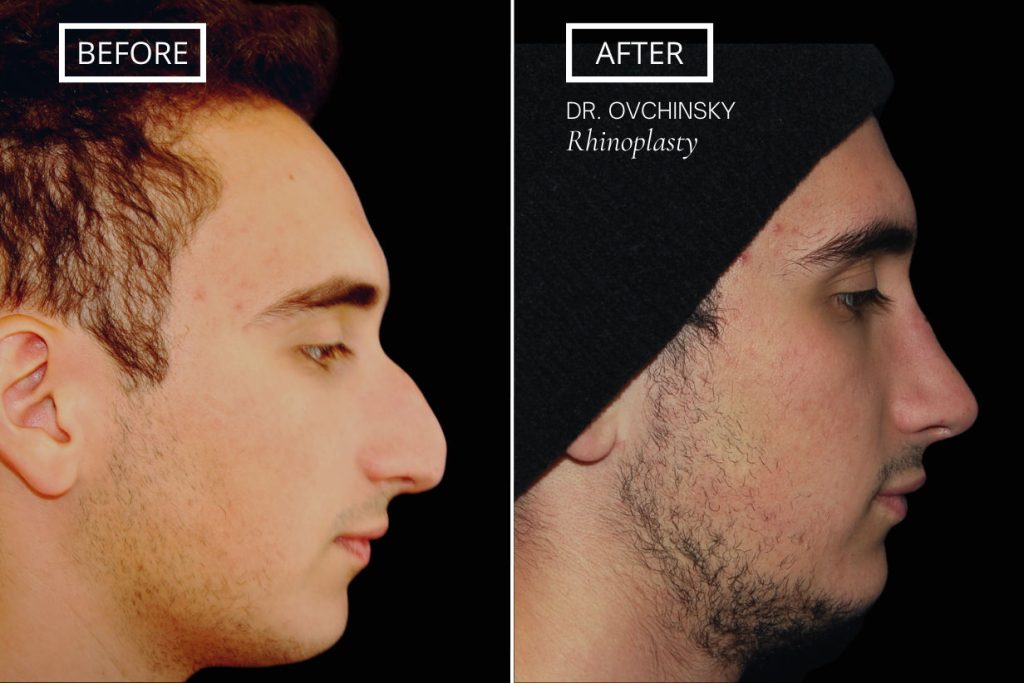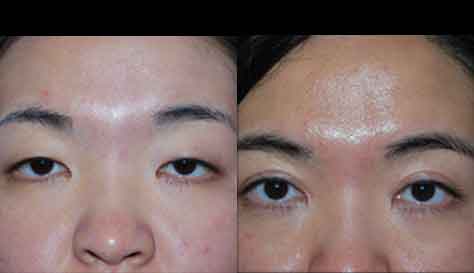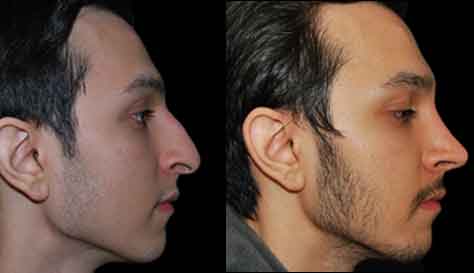Male Rhinoplasty
Conveniently located to serve the areas of New Jersey and New York

Male rhinoplasty is a cosmetic procedure that focuses on the characteristics of the male face to perform a “nose job.” Rhinoplasty is the surgical alteration of the nose that typically reduces certain nasal aspects to achieve facial harmony. Unlike rhinoplasty for female patients, male-specific rhinoplasty considers both the personal and societal expectations of how a male nose should look. It brings to light the observed nasal standards for male patients to construct both a strong and aesthetically pleasing nasal structure. Rhinoplasty is one of the most common cosmetic surgeries performed for male patients. (1)
Dr. Alexander Ovchinsky is a double board-certified facial plastic surgeon who specializes in rhinoplasty. With a deep understanding of how the procedure is performed to achieve the desired nasal contour, he serves the patients of Short Hills, NJ, and Brooklyn, NY at Plastic Surgery of Short Hills. If you are ready to schedule a male rhinoplasty consultation with Dr. Ovchinsky, please fill out our short contact form. You may also call us directly at:
(973) 379-0101 – Short Hills, NJ
(718) 646-1234 – Brooklyn, NY
Contents
What is Male Rhinoplasty?
A man’s nose should look like a man’s nose. This is a seemingly easy concept but may not be followed by plastic surgeons. A female nose can be slightly rotated or have a slightly narrower appearance, both normal and natural variations. A man’s nose, however, will look odd if the tip is overly rotated or pinched. A relatively straight profile is paramount on a male face, but on a female face, slightly scooped dorsum is acceptable. A straight profile or even a slight convexity to the bridge can make it difficult for outside observers to tell if there has been a rhinoplasty. (1)
A 2018 study found that the manipulation and reduction of the dorsal hump has more impact on the perceived attractiveness of a male patient. (2) Dr. Ovchinsky focuses on each patient’s ideal male nasal contour to help them achieve their dream nose. This often involves reducing the dorsal hump, correcting dorsal deviation and improving the appearance of nasal tip.
Osteotomies (narrowing of the nasal bones) are quite different in a male rhinoplasty and a female rhinoplasty. Females can and often seek slight narrowing of the nose on frontal view. A male nose is narrowed with caution. A tell-tale sign of a male rhinoplasty is two indentations on the sides of the nose, which is an indication that the surgeon has been too aggressive with the osteotomies.
Why is Male Rhinoplasty Performed?
Male rhinoplasty is more common than most realize, especially when contact sports injuries create misshapen or damaged noses. Male patients might especially want rhinoplasty after contact sports injuries, accidents, or other incidents in which they experience trauma to their nose; and many desire repair over complete change when they do undergo rhinoplasty.
In the event, the nose is broken as a result of trauma, a septal deviation can occur. A deviated septum can quickly cause an obstructed airway, which then leads to snoring, sleep problems, and difficulty with exercise. Breathing difficulties alone make undergoing rhinoplasty an important option.
You can find most of the answers to your questions about rhinoplasty surgery on our website under “Rhinoplasty FAQ”.
Benefits of Male Rhinoplasty
Male rhinoplasty patients commonly choose rhinoplasty for a combination of functional and aesthetic reasons. The appearance of the nose affects the entire look of the face, and changing it in even minor ways can give patients a much-needed self-esteem boost.
Male rhinoplasty improves the overall appearance and function of the nose with the most natural, undetected results. It may correct a short or long nose, increase the tip length, or just refine it, reduce the nasal bridge, correct nasal deviation, and eliminate a dorsal bump. Whether your irregularities are congenital or the results of an old sports injury or scuffle, Dr. Ovchinsky provides the most natural results that restore balance and symmetry to a man’s face without taking away his masculinity.
Rhinoplasty Candidates
Good candidates for rhinoplasty may have:
- High/low nasal bridge or dorsal hump
- Crooked nose
- Overly-flared nostrils
- Trouble breathing
- Bulbous (rounded) nasal tip
- Concerns with the shape and/or size of their nose
The ideal patient for male rhinoplasty is looking to change the nasal structure without losing their masculine features and have realistic expectations of what surgery can achieve. Rhinoplasty is an extremely intricate procedure, and patients must know that perfection may not be possible going into it. They are in good overall health with no serious or underlying medical concerns. A good candidate is also a non-smoker or willing to quit at least 2 weeks before their scheduled procedure.
Personal Consultation with Dr. Ovchinsky
Dr. Ovchinsky will consider and discuss several factors during the surgical consultation. These include skin type and ethnicity, elements of the nose that will benefit from surgical improvement, and the overall function of the nose. All of this information will help to determine if rhinoplasty is the right procedure for you. After a thorough nasal examination, which may include nasal endoscopy (looking inside the nose with the camera), your photographs will be taken and Dr. Ovchinsky will simulate surgical results for you. This will be your chance to review the simulation and discuss what you like and don’t like.
Preparation
If you are on blood thinning medication, Dr. Ovchinsky will ask you to stop taking them approximately one week before surgery. He will also ask that you avoid certain over-the-counter medications, particularly non-steroidal anti-inflammatories and aspirin. Completely quit smoking tobacco and nicotine products at least two weeks before surgery. You may continue taking most routine medications up until the morning of surgery with a small sip of water.
Before your surgery date, we require you to find a loved one or trusted friend to transport you to and from our surgical facilities. Rhinoplasty utilizes general anesthesia, so you will not be able to take yourself home afterward. It is also essential to pick up all prescriptions and aftercare necessities beforehand to ensure a smooth recovery.
Male Rhinoplasty Procedure
Depending on the patient, Dr. Ovchinsky starts a rhinoplasty surgery by accessing the nasal cavity with an “open” or “closed” approach. An open rhinoplasty requires incisions inside the nostrils and one small incision at the bottom of the nasal tip (columella). This approach allows him more visibility and room for more complicated rhinoplasty. During a closed approach, Dr. Ovchinsky uses only internal incisions to prevent scarring.
Dr. Ovchinsky tailors his surgical technique to the individual patient rather than using the same “run-of-the-mill” surgery on everybody. The technique he uses causes minimal pain, has natural results, and is long-lasting. Finally, with Dr. Ovchinsky’s technique and attention to detail during skin closure, scars are typically minimal and are often difficult to see once they have fully matured.
Recovery & Results
After the rhinoplasty procedure, we will take you to our recovery room until the anesthesia wears off. Once you are stable your family member or friend can take you home. Stay relaxed for the first few days. You will need to keep your head elevated when in bed to help with faster resolution of swelling. Begin to start walking, eating, and using the restroom the day after surgery. Advance your diet from liquids to soft food to solids as tolerated. To prevent dehydration, please drink as much juice and nutritional fluid as possible.
Slowly increase your activity each day. It typically takes up to 2 weeks before you start to feel like your old self again. Avoid any strenuous activity for 4 weeks. Take the medication prescribed to you by Dr. Ovchinsky, which usually includes antibiotics, pain medicine, ointment for the incisions, and occasionally anti-nausea medications. Where necessary, he will remove your stitches around one week after your surgery.
When Will I See My Rhinoplasty Results?
The vast majority of patients are quite surprised afterward at how little discomfort they have and how quickly they return to normal activity. Most patients have minimal bruising. You may see the difference in your nose right away, and more so once the swelling goes down within the first 1 to 2 weeks. As with any rhinoplasty procedure, it can take up to 12 months for the results to become final.
How Much Does Male Rhinoplasty Cost in New Jersey?
Male rhinoplasty is a highly customized and specific surgery for each patient who receives it. Dr. Ovchinsky creates a procedure plan that works for you, and your total cost reflects that. To receive an estimated total cost for your rhinoplasty, please schedule your private consultation with Dr. Ovchinsky today by filling out this form. You may also call our Short Hills, NJ or Brooklyn, NY locations at (973) 379-0101 and (718) 646-1234 respectively.
FAQ
What makes a male rhinoplasty different from a female rhinoplasty?
Masculine nasal surgery involves addressing specific concerns unique to male patients, such as enhancing nasal contours, refining nasal proportions, and improving overall facial symmetry. Men’s rhinoplasty procedures are designed to maintain or enhance the inherent masculinity of the face while achieving the desired aesthetic outcome.
Can I get a non-surgical rhinoplasty?
In some cases, non-surgical options like dermal fillers may offer temporary improvements for minor nasal irregularities. However, for significant structural changes, surgical rhinoplasty remains the gold standard for achieving permanent results.
How do I choose a rhinoplasty surgeon?
Selecting a skilled and reputable plastic surgeon is crucial for achieving optimal results with male rhinoplasty. Look for a surgeon who specializes in rhinoplasty and has a proven track record of successful outcomes. Reading patient reviews and viewing before-and-after photos can help you choose the right surgeon for your needs.
References
- Nuyen B, Kandathil CK, Mikhail Saltychev, Most SP. Social Perception of the Nasal Dorsal Contour in Male Rhinoplasty. JAMA Facial Plastic Surgery. 2019;21(5):419-425. doi:https://doi.org/10.1001/jamafacial.2019.0321
- Kandathil CK, Saltychev M, Moubayed SP, Most SP. Association of Dorsal Reduction and Tip Rotation With Social Perception. JAMA Facial Plastic Surgery. 2018;20(5):362. doi:https://doi.org/10.1001/jamafacial.2018.0317





